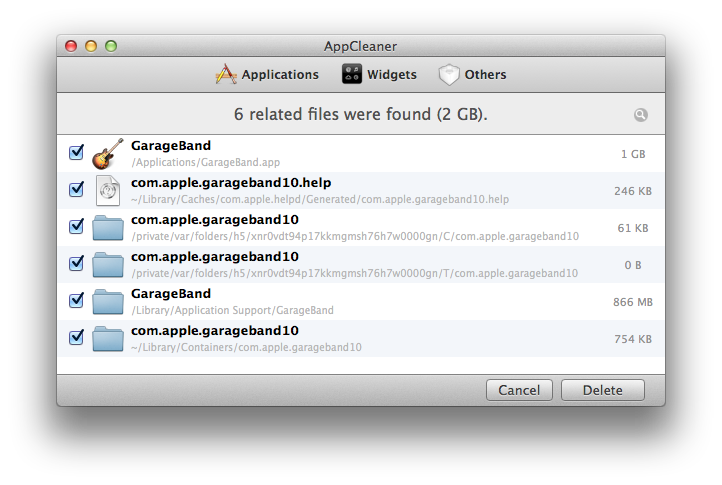- Today, I noticed a Logic folder in Application Support that's almost 800MB. The largest sub-folder is EXS Factory Samples (637MB), which contains 'Drum Kit Designer', '01 Acoustic Pianos' and '07 Guitars'. Since I don't use Logic do I need these folders? If I delete the Logic folder, will it have any effect on GarageBand? Thanks in advance.
- Now we want to delete the original content: on the System drive, delete the Logic folder inside /Library/Application Support/. It’s finally time to create our symlink. First we set the shell to root: in the Terminal, write sudo -s and press enter.
- Mac Library Logic Folder Template
- Mac Library Logic Folders
- Mac Library Logic Folder Download
- Mac Library Logic Folder Examples
With these formats, just as with EXS settings, all the front-panel settings will have been stored in the Project file, so everything will look correctly, but if the EXS Instrument is not found (or Aliased) in one of the necessary locations (Logic Project folder, User Music folder, or root Library folder), you'll hear the weird, telltale sine.
VCF modelled after the Korg MS-20
Noise generator for cymbals
Buchla-style wavefolder
Bank of RC lowpass filters
The music produced by rotating planets
4-channel polyphonic merge and split.
Serge Style Programmer/Sequencer
VCO based on generated waveform
Phase-coupled oscillator system
Converts clock signals to V/Oct signals
Octal clip distortion module
Octal offset module
8 2-in 1-out switch (A/B Y)
Octal three-inputs signal averager
8 times slew-limiters/function generators/A-R envelopes
8 three inputs Min/And operator
Mac Library Logic Folder Template
8 Positive/Negative Rectifier
8 times three input Max/Or operator
Analog to Digital Converter
8-bit Digital to Analog Converter
8 Variable length Sample&Holds
Sample and Hold, Clock and Noise Generator
Analog Comparator Functions
A unique arpeggiator with polyrhythmic capabilities
Animated panel
utility to enhance Regen Modular Frames
Add Irrational Rhythms to QAR
Fun Compressor
XG-202 4-Input Polyphonic XOR Gates
VM-202 2-Channel Vintage VU-Meter
VM-201 Vintage VU-Meter
VM-102 2-Channel VU-Meter

VM-101 VU-Meter
OG-202 4-Channel Polyphonic OR Gates
OA-105 Op-Amps
OA-103 Op-Amps
Mac Library Logic Folders
NG-206 Polyphonic NOT Gates
AG-202 4-input Polyphonic AND Gates
8 bits analog shift register
8 Absolute value operators
8 Not operators
8 difference calculators
8 three to one unity mixers
8 four-quadrant multipliers / ring modulators
8x Comparator
A blank panel with an illustration of the Sony S-SMP chip on the Super Nintendo Entertainment System (SNES).
An emulation of the Gaussian interpolation filter effect from the S-SMP chip on the Super Nintendo Entertainment System (SNES).
An emulation of the echo effect from the S-SMP chip on the Super Nintendo Entertainment System (SNES).
An emulation of the ADSR envelope generator from the S-SMP chip on the Super Nintendo Entertainment System (SNES).
VCV Library Instructions
- Download and install VCV Rack.
- Register for a VCV account and log in using Rack’s “Library” menu.
- Subscribe to a plugin, relaunch Rack, and click “Library > Update all” in the menu bar.
- Adding individual modules will be allowed when Rack v2 is released, since this relies on its module whitelist feature. Until then, you must subscribe to the entire plugin.
- Restart Rack and add the new module(s) to your patch.
All plugins on the VCV Library are available for Windows, Mac, and Linux.The “major” version (i.e. vMAJOR.MINOR.REVISION) must match between Rack and its plugins.For example, Rack v1.* can only load v1.* plugins.
Missing or incorrect information in this database, such as a missing tag? Inform the plugin author(s) using the contact information on their plugin/module page.
Developers: see Adding your plugin to the VCV Library.
Notes
Purchasing plugins with the “VCV” brand supports the VCV Rack project.See VCV’s Mission Statement to learn how VCV Rack development is funded.
Prices are in US Dollars.
VCV is only responsible for VCV-branded plugins and does not completely review all third-party plugins on this website. VCV does not provide technical support for third-party plugins. Like VST/AU plugins, installing plugins from unknown sources may compromise your computer and personal information. VCV is not responsible for plugins that may damage your computer or invade your privacy.
By purchasing a plugin on the VCV Library, you agree to the End User License Agreement and Refund Policy.
Email contact@vcvrack.com for questions and issues about VCV Library.

I get many questions on how to move Logic’s additional content (Apple Loops, samples…) to an alternative location, like a secondary internal or external drive. There’s widespread information about using aliases when linking back to Logic Pro X’s default locations. Unfortunately that is a very risky assumption, because every update related to that content will overwrite the alias and recreate an ordinary folder instead. The problem is that your other content will be orphaned, and you will end up with library content that needs to be redownloaded again.
The correct way of do this is to use symbolic links.
The Symbolic Link
Symbolic links, or symlinks, are part of the underlying file system that the UNIX BSD kernel in OS X uses as its backbone. Symlinks basically contain information to the file path itself but not to the files. It stores the information of the so called inode, whereas an alias contains a reference to the path as well as the actual file itself.
One of the advantages of using an alias is that you can rename and move the referenced file without losing its relationship. This is in general a huge advantage over symlinks, but has the downside of being treated by the file system like a small file, instead of a referenced location. That’s why an update will remove the alias and create a new folder in its place.
A symlink will, as I stated before, only store the path. Moving the target file or folder will break the link. Changing the name of the file or folder will also break the link. Creating a whole different file and placing it under the same path with the same name will however work flawlessly. One of the strengths of the symlink is that the system treats it as a path to a location. This is why it stays intact even when updating your libraries.
How to create a Symbolic link
The easiest way to create a symlink is to use the Terminal. You can find this application inside the Utilities folder which lives inside your Applications folder. Apple’s Finder does not provide any way of creating symlinks directly, as an alias is the prefererred way of linking to a file. If you however find the terminal too heavy or scary, there are small scripts that can help you out. I recommend you use the Terminal though, simply because it’s a very easy task and getting your hands warm in the Terminal will have other benefits later on.
Launch the Terminal and type this command:
ln -s [Target] [Destination]
- [target] is where your files are.
- [destination] is the symbolic link file itself. Here we are going to use the default library location.
OS X’s terminal offers the ability to drag and drop paths directly from the Finder. You will not have to enter much text at all.
Scenario 1 – Moving our content and linking to it.
In this scenario we are going to move an existing folder with its content, and create a symlink in its place.
Locate /Library/Application Support/Logic and move the “Logic” folder to your external drive. I recommend you first create a folder on that drive to keep all your content in one place. The new location for the content is as follows:

[NAME OF YOUR DISK]/Logic Content/Logic
- “Logic Content” is the name of the folder I created.
- “Logic” is the moved folder.
Now we want to delete the original content: on the System drive, delete the Logic folder inside /Library/Application Support/.
Mac Library Logic Folder Download
It’s finally time to create our symlink. First we set the shell to root: in the Terminal, write sudo -s and press enter. It will prompt you for your password: type it and press enter. Now type ln -s followed by a space. Drag and drop the Logic folder from your external drive onto the terminal window. Next, drag and drop the Application Support folder inside the main Library. You will see this displayed in the terminal:
ln -s /Volumes/[NAME OF YOUR DISK]/Logic Content/Logic /Library/Application Support
Press back space to get rid of the blank space and enter /Logic to name your link “Logic”. You should now see:
ln -s /Volumes/[NAME OF YOUR DISK]/Logic Content/Logic /Library/Application Support/Logic
Mac Library Logic Folder Examples
Lastly press Enter, and the symlink is created.
Scenario 2 – Creating links even before installing Logic.
You can create the links before installing Logic Pro X. I recommend you create a main folder first, followed by a subfolder on that drive to keep all your content in one place. In this example I create a “Logic Content” folder, and inside that I create a new “Logic” folder. The path now looks like this:
[NAME OF EXTERNAL DRIVE]/Logic Content/Logic
In Terminal, type ln -s followed by a space. Drag and drop the Logic folder from your external drive onto the Terminal window. Next type /Library/Application Support/Logic and you will see this on the Terminal:
ln -s /Volumes/[NAME OF YOUR DISK]/Logic Content/Logic /Library/Application Support/Logic
Press enter and your symlink is created.
Important folders for Logic Pro X additional content
There are four locations on your Mac that contain files used by Logic Pro. You don’t need to move all of these if you don’t want to, but it’s good to know where all the content is installed:
/Library/Application Support/Logic
/Library/Application Support/GarageBand
/Library/Audio/Apple Loops
/Library/Audio/Impulse Responses
The largest folders in size are the Apple Loops and the Logic folder. You can now follow the steps in one of the scenarios above to either create or move as many folders as you want.
I hope this is a good introduction in how to move your additional content, and I’ll see you on the next blog post.
Sincerely,
/Eric Cardenas
Eric Cardenas
Vocalist, Bass player, and Guitarist based in Uppsala, Sweden
Audio engineer with an affinity for computers working primarily in Logic Pro.
Comments are closed.